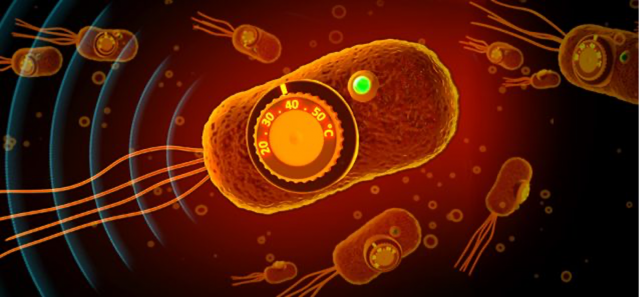Targeting Cancer Cells with Ultrasound-Directed Bacteria

Tumor-homing therapeutic bacteria remotely controlled by thermal focused ultrasound. Image credit: Shapiro lab.
New pioneering research conducted by scientists from the lab of Mikhail Shapiro, ICB project leader and Caltech professor of Chemical Engineering, has demonstrated a new mechanism for reducing cancerous tumor growth and overcomes the limitations of most current microbial cancer therapies with the use of genetically engineered therapeutic bacteria that are remotely controlled by thermal focused ultrasound (FUS). Their work is published in the March 24 issue of the journal Nature Communications.
"The goal of this technology is to take advantage of the ability of engineered probiotics to infiltrate tumors, while using ultrasound to activate them to release potent drugs inside the tumor," says Shapiro.
The team developed a FUS-activated therapeutic bacteria in which a brief thermal stimulus activates sustained release of anti-cancer immunotherapy. They engineered these cellular agents by adapting temperature-sensitive repressors to the tumor-homing probiotic species E. coli Nissle 1917. In a mouse cancer model, they showed that the resulting engineered microbes are reliably and chronically activated by a brief, noninvasive FUS treatment after systemic administration to release therapy and successfully suppressed tumor growth.
"Focused ultrasound allowed us to activate the therapy specifically inside a tumor," says Mohamad Abedi, a former PhD student in Shapiro's group who co-led the project. "This is important because these potent drugs, which are so helpful in tumor treatment, can cause significant side effects in other organs where our bacterial agents may also be present."
Through a series of trials, the researchers found that mice treated with this strain of bacteria and FUS showed much slower tumor growth than mice treated only with ultrasound, mice treated only with the bacteria or mice that were not treated at all.
"This is a very promising result because it shows that we can target the right therapy to the right place at the right time," Shapiro says. "But as with any new technology there are a few things to optimize, including adding the ability to visualize the bacterial agents with ultrasound before we activate them and targeting the heating stimuli to them more precisely."
This technology provides a critical tool for the spatiotemporal targeting of potent bacterial therapeutics in a variety of biological and clinical scenarios.
